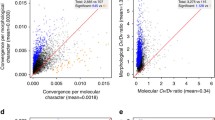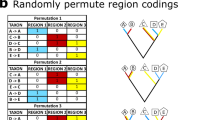Summary
In an attempt to resolve some points of branching order in the phylogeny of the eutherian mammals, a phylogenetic analysis of 26 nuclear and 6 mitochondrial genes was undertaken using a maximum likelihood method on a constant rate stochastic model of molecular evolution. Seventeen of the nuclear genes gave a primates/artiodactyls grouping highest support whereas three of the mitochondrial genes found a rodents/artiodactyls grouping to be best supported. The primates/rodents grouping was never the best supported. On the assumption that rodents are indeed an outgroup to primates and artiodactyls and that the latter taxa diverged 70 million years ago, an estimation was made, for each gene, of the time of divergence of the rodent lineage. In most cases such estimates were beyond the limits set by present interpretations of the paleontological record as were many estimates of the divergence time of mouse and rat. These results suggest that, although there is locus variation, the divergent position of the rodent lineage may be an artifact of an elevated rate of nucleotide substitution in this order.
Similar content being viewed by others
References
Bishop MJ, Friday AE (1985) Evolutionary trees from nucleic acid and protein sequences. Proc Roy Soc Lond B 226:271–302
Brown WM, Prager EM, Wang A, Wilson AC (1982) Mitochondrial DNA sequences of primates: tempo and mode of evolution. J Mol Evol 18:225–239
Bulmer M (1989) Estimating the variability of substitution rates. Genetics 123:615–619
Corbet GB, Hill JE (1980) A world list of mammalian species. British Museum (Natural History), Comstock Publishing Associates, London
Devereux J, Haederli P, Smithies O (1984) A comprehensive set of sequence analysis programs for the VAX. Nucleic Acids Res 12:387–395
Easteal S (1988) Rate constancy of globin gene evolution in placental mammals. Proc Natl Acad Sci USA 85:7622–7626
Easteal S (1990) The pattern of mammalian evolution and the relative rate of molecular evolution. Genetics 124:165–173
Edwards AWF (1972) Likelihood. Cambridge University Press, Cambridge
Flynn LJ, Jacobs LL, Lindsay EH (1985) Problems in muroid phylogeny: relationship to other rodents and origin of major groups. In: Luckett WP, Hartenberger J-L (eds) Evolutionary relationships among rodents: a multidisciplinary analysis. NATO ASI series. Plenum, New York, p 589–616
Gillespie JH (1986) Natural selection and the molecular clock. Mol Biol Evol 3:138–155
Hasegawa M, Kishino H (1989) Confidence limits on the maximum-likelihood estimate of the hominoid tree from mitochondrial-DNA sequences. Evolution 43:672–677
Holmes EC, Pesole G, Saccone C (1989) Stochastic models of molecular evolution and the estimation of phylogeny and rates of nucleotide substitution in the hominoid primates. J Hum Evol 18:775–794
Kimura M (1983) The neutral theory of molecular evolution. Cambridge University Press, Cambridge
Kishino H, Hasegawa M (1989) Evaluation of the maximum likelihood estimate of the evolutionary tree topologies from DNA sequence data, and the branching order of the Hominoidea. J Mol Evol 29:170–179
Li W-H, Tanimura M, Sharp PM (1987) An evaluation of the molecular clock hypothesis using mammalian DNA sequences. J Mol Evol 25:330–342
Lillegraven JA, Thompson SD, McNab BK, Patton JL (1987) The origin of eutherian mammals. Biol J Lin Soc 32:281–336
Novacek MJ, Wyss AR, McKenna MC (1988) The major groups of eutherian mammals. In: Benton MJ (ed) The phylogeny and classification of the tetrapods, vol. 2. Mammals. Systematics Association special vol. 35B. Clarendon Press, Oxford, p 31–71
Saccone C, Pesole G, Preparata G (1989) DNA microenvironments and the molecular clock. J Mol Evol 29:407–411
Takahata N (1987) On the overdispersed clock. Genetics 116: 169–179
Thompson EA (1975) Human evolutionary trees. Cambridge University Press, Cambridge
Wilson AC, Ochman H, Prager EM (1987) Molecular time scale for evolution. Trends Genet 3:241–247
Wolfe KH, Sharp PM, Li WH (1989) Mutation rates differ amoung regions of the mammalion genome. Nature 337:283–285
Wu C-I, Li W-H (1985) Evidence for higher rates of nucleotide substitution in rodents than in man. Proc Natl Acad Sci USA 82:1741–1745
Wyss AR, Novacek MJ, McKenna MC (1987) Amino acid sequence versus morphological data and the interordinal relationships of the mammals. Mol Biol Evol 4:99–116
Author information
Authors and Affiliations
Rights and permissions
About this article
Cite this article
Holmes, E.C. Different rates of substitution may produce different phylogenies of the eutherian mammals. J Mol Evol 33, 209–215 (1991). https://doi.org/10.1007/BF02100671
Received:
Revised:
Accepted:
Issue Date:
DOI: https://doi.org/10.1007/BF02100671




